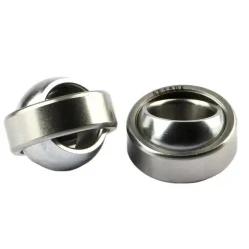Types of plain bearings
2023-12-04
Plain bearings, also known as sleeve bearings or bushings, are a type of bearing that relies on a sliding motion between two surfaces to support and guide the rotating or reciprocating shaft. Unlike rolling-element bearings, plain bearings have no rolling elements (balls or rollers) but instead use a sliding layer of material. Here are some key features and types of plain bearings:
1. Structure:
- Consist of two main components: an inner sliding surface (typically the shaft or journal) and an outer sliding surface (typically the bearing housing or sleeve).
- The space between these surfaces is filled with a lubricating film, such as oil or grease, to reduce friction and wear.
2. Types of Plain Bearings:
- Sleeve Bearings: Simple cylindrical bearings with a sliding surface. Commonly used in various applications where simplicity and cost-effectiveness are essential.
- Flanged Bearings: Similar to sleeve bearings but with a flange to aid in axial positioning. Often used in applications where axial movement needs to be restricted.
- Thrust Washers: Thin, flat bearings used to support axial loads. They are often used in conjunction with other types of bearings in thrust applications.
- Split Bearings: Bearings that come in two halves, allowing for easy installation and removal without the need to disassemble the equipment.
3. Materials:
- Metal Plain Bearings: Commonly made of materials such as bronze, brass, or steel. These metals provide good strength and wear resistance.
- Polymer Plain Bearings: Made of materials like nylon, polyethylene, or PTFE (Teflon). Polymer bearings are known for their self-lubricating properties and resistance to corrosion.
- Bimetal Bearings: Consist of two layers, typically a steel backing and a layer of softer metal such as bronze. This combination provides strength and wear resistance.
4. Advantages:
- Simple Design: Plain bearings have a straightforward design, making them easy to manufacture and maintain.
- Cost-Effective: They are often more cost-effective than rolling-element bearings.
- High Load Capacity: Can handle high loads and shock loads.
5. Limitations:
- Friction: Plain bearings generally have higher friction compared to rolling-element bearings.
- Limited Speeds: They are not suitable for high-speed applications.
- Regular Maintenance: Lubrication and maintenance are crucial to prevent excessive wear.
6. Applications:
- Plain bearings are used in a wide range of applications, including automotive components, industrial machinery, construction equipment, and more.
While plain bearings may not be as well-suited for high-speed or precision applications, their simplicity and durability make them suitable for various situations, especially those where cost-effectiveness and high load capacity are essential. Proper lubrication and maintenance are crucial to ensure the longevity and efficient operation of plain bearings.



